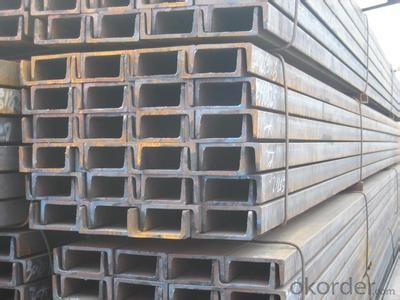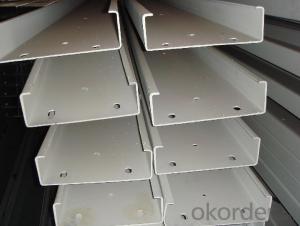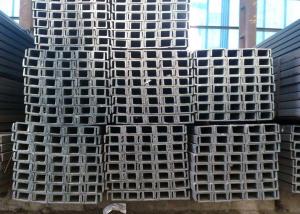Prime Hot Rolled Channel Steel from China GI Channel Steel Channel
- Loading Port:
- Tianjin
- Payment Terms:
- TT OR LC
- Min Order Qty:
- 2000 PCS
- Supply Capability:
- 40000 PCS/month
OKorder Service Pledge
OKorder Financial Service
You Might Also Like
Prime Hot Rolled Channel Steel from China GI Channel Steel Channel Details
Standard: | AISI,ASTM,BS, DIN,GB,JIS | Dimensions: | 50*37*4.5mm-400*104*14.5mm | Grade: | Carbon steel |
Place of Origin: | Shanghai China (Mainland) | Brand Name: | Baosteel Masteel Ansteel Shousteel Shasteel | Model Number: | Q195,Q215,Q235, A36,SS400,SS540 |
Shape: | GI Channel | Application: | Construction;Vehicle manufacturing; Industrial structure etc. | Perforated Or Not: | Not Perforated |
manufacturing technique: | Hotrolled Can be processed again repeatedly | sulphur content: | Q235B/S(0.02)% S355JR/S(0.013)% | Phosphorus Content: | Q235B/P(0.03)% S355JR/P(0.012)% |
silicon content: | Q235B/Si(≥0.19)% S355JR/Si(≥0.002)% | manganese content: | Q235B/Mn(0.45)% S355JR/Mn(1.35)% | Carbon Content: | Q235B/C(0.12-0.20)% Q3S355JR/C(0.12-0.20)% |
elongation: | Q235B/26min S355JR/26min | strength of extension: | Q235B/420MPa S355JR/485MPa | Yield Strength: | Q235B/235-280MPa S355JR/335-360MPa |
breed classify: | semi-killed steel or killed steel |
Packaging & Delivery
| Packaging Detail: | Prime hot rolled gi channel from china 1. It can be packed by container or bulk vessel. 2. 20ft container can load 25 tons, 40ft container can load 26 tons. 3.Standard export seaworthy package, it use wire rod with bundle according product's size. 4.Or we can make it as your requirement. |
| Delivery Detail: | 15 working days after received the deposit or L/C. |
Prime Hot Rolled Channel Steel from China GI Channel Steel Channel Specifications
Prime hot rolled gi channel
Competitive price
Fast delivery time
Customized length
Prime Hot Rolled Channel Steel from China GI Channel Steel Channel Pictures


- Q: Can steel channels be used in the aerospace parts manufacturing industry?
- Yes, steel channels can be used in the aerospace parts manufacturing industry. Steel channels are often used in the construction of aircraft structures and components due to their high strength, durability, and resistance to deformation. They can be used in various applications such as framing, support structures, and reinforcement for critical aerospace parts. Steel channels provide structural integrity and stability, allowing for the safe and reliable operation of aerospace vehicles. Additionally, steel channels can be easily fabricated and welded, making them an ideal choice for the aerospace industry, where precision and quality are of utmost importance.
- Q: Can steel channels be used for HVAC systems?
- Yes, steel channels can be used for HVAC systems. Steel channels are commonly used as a structural component in HVAC systems due to their strength and durability. They can be used for supporting and securing ductwork, as well as providing a framework for the installation of HVAC equipment such as air handling units, fans, and filters. Steel channels are available in various sizes and configurations to accommodate different HVAC system requirements. Additionally, steel channels can be easily fabricated and installed, making them a popular choice for HVAC professionals.
- Q: What are the typical finishes available for steel channels?
- Steel channels can be finished in various ways to achieve different aesthetic and functional requirements. One option is to use hot-dip galvanizing, where the steel channel is immersed in molten zinc. This method not only provides excellent corrosion resistance but also adds a decorative touch with a shiny and even surface. Another choice is powder coating, which involves applying a dry powder onto the steel channel and then curing it with heat. This finish is highly durable and attractive, resistant to chipping, scratching, and fading. It can be customized in different colors to suit individual preferences and blend with the surroundings. Electroplating is also popular for steel channels. It entails immersing the channel in an electrolyte solution and passing an electric current through it, resulting in a layer of metal (such as chrome or nickel) being deposited on the surface. This process enhances the appearance of the channel with a smooth and shiny finish while providing some corrosion resistance. For a more natural and rustic look, steel channels can be left unfinished or with a bare metal finish. This option is often chosen for industrial or architectural designs where the raw and exposed metal is desired for its aesthetic appeal. In conclusion, the available finishes for steel channels include hot-dip galvanizing, powder coating, electroplating, and bare metal finishes. Each finish offers its own unique benefits in terms of corrosion resistance, durability, appearance, and customization options, providing a wide range of applications and design possibilities.
- Q: Are steel channels suitable for use in industrial settings?
- Yes, steel channels are highly suitable for use in industrial settings. Steel channels are versatile and robust structural components that provide excellent strength and stability, making them an ideal choice for various applications in industrial environments. One of the key advantages of steel channels is their high load-bearing capacity. Industrial settings often involve heavy machinery, equipment, and materials, which require strong and durable support structures. Steel channels can withstand significant loads and provide a reliable framework for various industrial operations. Moreover, steel channels are known for their resistance to corrosion and weathering. Industrial settings frequently expose materials to harsh conditions, such as moisture, chemicals, and extreme temperatures. Steel channels, especially those made from corrosion-resistant alloys, can withstand these environmental challenges and maintain their structural integrity over time. Another important factor that makes steel channels suitable for industrial settings is their versatility. Steel channels come in various shapes, sizes, and thicknesses, allowing them to be adapted to different requirements and applications. They can be easily fabricated, cut, and welded to create customized structures that meet specific industrial needs. Furthermore, steel channels offer excellent fire resistance, which is crucial in industrial environments where fire hazards are a concern. Steel has a high melting point and does not contribute to the spread of flames, making it a safe choice for industrial structures. In addition to their technical advantages, steel channels are also cost-effective in the long run. Steel is a durable material that requires minimal maintenance, reducing the need for frequent repairs or replacements. Moreover, steel is widely available and can be recycled, making it an environmentally friendly choice. In conclusion, steel channels are highly suitable for use in industrial settings due to their strength, durability, resistance to corrosion and fire, versatility, and cost-effectiveness. Whether it's for supporting heavy loads, creating customized structures, or withstanding harsh environments, steel channels offer reliable and efficient solutions for various industrial applications.
- Q: Can steel channels be used for modular construction?
- Modular construction can indeed utilize steel channels. These are steel components with a C-shaped cross-section that serve as structural elements. Their strength and versatility make them widely used in construction. For modular construction, steel channels can serve as the framework and support system for the modular units. They can be easily fabricated and assembled to create a robust and long-lasting structure. Moreover, their lightweight nature makes them ideal for modular construction, as they can be easily transported and assembled on-site. Furthermore, steel channels boast exceptional load-bearing capabilities, which are crucial for modular construction, given the need to support and distribute the weight of the modules. In summary, the strength, versatility, and ease of use make steel channels a favored option for modular construction.
- Q: Are steel channels suitable for high-rise construction?
- Yes, steel channels are suitable for high-rise construction. Steel channels provide structural strength, durability, and resistance to fire, making them an ideal choice for supporting heavy loads and tall structures. They can withstand the vertical and lateral forces experienced in high-rise buildings, ensuring stability and safety. Additionally, steel channels can be customized to meet specific design requirements, making them highly versatile for use in various high-rise construction applications.
- Q: How is the channel steel set on the wall?
- Channel steel is a strip of steel with a cross section. Section steel with groove shape.The specifications of channel steel are mainly expressed by height (H), leg width (b), waist thickness (d) and so on. At present, the specifications of domestic channel steel are from No. 5-40, that is, the corresponding height is 5-40cm.
- Q: How do you mark the types of steel such as channel, I-beam and so on in the document?
- Channel letters are in capital letters "C" or "half brackets" [...], and "I" in capitals"
- Q: What kind of low carbon steel or medium carbon steel are they?
- Low carbon steelLow carbon steel (low carbon steel) as the carbon content of less than 0.25% of the carbon steel, because of its low strength, low hardness and soft, it is also called the mild steel. It includes most of the ordinary carbon structural steel and some high-quality carbon structural steel, most of which are not used for engineering structural parts without heat treatment. Some of them are used for wear-resistant mechanical parts after carburizing and other heat treatment.The annealed structure of low carbon steel is ferrite and a small amount of pearlite, its strength and hardness are lower, and its plasticity and toughness are better. Therefore, its cold forming property is good, and cold forming can be carried out by curling, bending and stamping. This kind of steel also has good weldability. Carbon content from 0.10% to 0.30% low carbon steel is easy to accept all kinds of processing, such as forging, welding and cutting. It is used to make chains, rivets, bolts, shafts and so on.Low carbon steel is generally rolled into angle steel, channel steel, I-beam, steel pipe, steel belt or steel plate. It is used to make all kinds of building components, containers, boxes, furnaces and agricultural machinery and so on. High quality low carbon steel is rolled into thin board, making deep drawing products such as automobile cab, engine cover, etc., also rolled into bars, used for making mechanical parts of low strength requirement. Low carbon steel is not treated by heat before use. The carbon content is above 0.15%. It is treated by carburizing or cyaniding. It is used for shaft, shaft sleeve, chain wheel and other parts which require high surface temperature and good wear resistance.
Send your message to us
Prime Hot Rolled Channel Steel from China GI Channel Steel Channel
- Loading Port:
- Tianjin
- Payment Terms:
- TT OR LC
- Min Order Qty:
- 2000 PCS
- Supply Capability:
- 40000 PCS/month
OKorder Service Pledge
OKorder Financial Service
Similar products
Hot products
Hot Searches
Related keywords

























